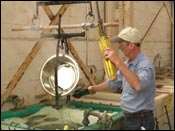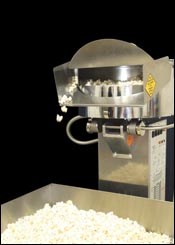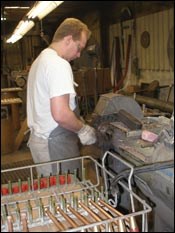Family Business Thrives on Plating Quality and Customer Service
Appears in Print as: 'Still Plating After All These Years'
Family business keeps poppin’
#management #masking #pollutioncontrol
Any family-owned company that’s been in business for nearly 60 years and still has its original customer must be doing something right. Case in point: Leonhardt Plating Co. (Cincinnati, OH).
“Our niche is based on quality and service, and many of our jobs are labor-intensive,” says Joe Leonhardt, who with his brothers and cousin represents the third generation to operate the business. “Everything that goes out has our name on it. We’ve been here more than 50 years in a tough business, and we’re here for the long term. Our customers know that.”
Featured Content
Founded in 1950, Leonhardt Plating currently employs 27 people in a 20,000-sq ft shop. The company provides metal finishing services including polishing, buffing, plating and electropolishing to more than 300 customers in a variety of industries. Common substrate materials for polishing and plating are steel and brass, and, for the electropolishing business, stainless steel.
Like other platers, the company has seen its share of jobs evaporate, either going offshore or to a different domestic plater. Leonhardt minimizes the pain by focusing on larger components with relatively low volumes and lots of value added.
“We like to take in more difficult jobs,” Joe Leonhardt says. “Many of our jobs involve a lot of hand polishing, then plating. There aren’t a lot of jobs we won’t quote, but for high-volume jobs we’re just not going to be competitive with some of the fully automated shops. So we don’t look for the seat belt buckles; we look for the jobs that we can take and add more value to them, from processing to packaging and delivery.”
The World Wide Web helps to keep business steady by allowing the company to cast a wider net for potential customers. “Even a few years ago, the work was more local or regional,” Leonhardt says. “It used to be Indianapolis, Louisville and Columbus; now it’s Cleveland, Detroit, Chicago, Nashville. And, with the Internet, they find us as often as we find them. So we’re doing quotes for potential customers from farther out geographically.”
When the worst does happen and work goes away, it doesn’t necessarily mean the end for a company that provides a variety of processes. For example, one plating job Leonhardt had for years was moved to a competitor in Michigan. The parts soon came back—this time in the form of work for Leonhardt’s in-house stripping department. “The new plater was getting a lot of rejects, and they were sending them to us for stripping,” Joe Leonhardt recalls. “We were happy to do it and send them back, and we definitely were making money on the stripping. It’s funny, but that’s just the nature of the plating business.”
Chrome Kettles
One job that illustrates the way Leonhardt Plating likes to work is finishing of kettles for commercial popcorn
poppers such as those seen in movie theaters. The customer is located in Cincinnati and makes anywhere from 10–20 machines per day with a variety of kettle sizes and configurations. “Delivery is one of the keys on that job,” Leonhardt says. “They can’t be held up by the kettle. We polish those parts to a mirror finish, nickel plate them and finish with decorative chrome. Then we package and ship them.”
Processing of the kettles starts at one of a half-dozen hand polishing stations consisting of a belt sander and either a buffing wheel or satin wheel. From there, assembly hardware on the components is masked in preparation for bright nickel electroplating. Leonhardt Plating operates five 1,000-gal bright nickel lines and a 1,000-gal semi-bright nickel line in addition to two 600-gal decorative chrome lines, two electroless nickel lines, two electropolishing lines, a gold plating tank and a nickel stripping line.
Preplate cleaning is a primary focus on the kettles, which come to the plating line with residual buffing compound on the surface. Initial hot alkaline cleaning is followed by alkaline electrocleaning, rinse, and acid dip stages. Parts then go for a dip in the nickel tank for 35–40 min before multiple rinse stages.
According to Joe Leonhardt, the company looks for nickel deposit thickness of 0.0005–0.001 inches. “The big thing is plating the inside surface of the kettle,” he says. “That’s why it spends 35–40 min in the nickel bath, to plate the inside surface and to achieve the required brightness and leveling.”
After multiple DI water rinses, kettles are ready for decorative chromium plating, which takes only 1–2 min. The company’s decorative chrome lines use hexavalent chemistry at a process temperature of 100°F.
“We’ve looked at trivalent decorative chemistries, but some of the pieces we run have to match other pieces,” Leonhardt explains. “That’s the main thing that’s been holding us back.”
Working with hex chrome is not particularly difficult, Leonhardt says. “We only have two baths, and we run at low chromium concentration to avoid burning. We have to check surface tension every 40 hr of operation, so we have a meter on the rectifier to track when it runs. At 40 hr, we sample for surface tension and use a wetting agent if needed. So basically we monitor surface tension regularly and we don’t have a problem. It takes us a while to generate 40 hr of operation.”
Bath maintenance on the electrolytic nickel lines is also pretty basic. “We monitor pH and add brightener as needed on the bright nickel lines, and once a month we send a sample to the vendor’s lab for analysis,” Leonhardt says. The company’s semi-bright nickel uses no brighteners and results in a dull nickel finish. It’s used to improve corrosion resistance on some aftermarket automotive parts and components for marine applications.
Joe Leonhardt believes that most plating problems can be traced to either poor cleaning or filtration, so the company takes pains to make sure parts entering the plating baths are absolutely clean. “I’d bet that most problems with process tanks involve contamination,” he says. That’s why we spend so much time and labor to clean our parts and remove all that buffing compound and other potential contaminants. As a result, we just don’t have those kinds of problems.”
Long-Term Job
Another job that has been in the shop literally for as long as the company has existed is finishing of tubing in a variety of configurations for a Cincinnati-based manufacturer of high-end medical and dental chairs. “This company was my grandfather’s original customer back in 1950,” Joe Leonhardt says.
Process steps are similar to those performed on the popcorn kettles: tubes and other chair components are polished, nickel plated and finished with decorative chrome. “Doctors and dentists use these heavy-duty chairs,” Joe Leonhardt explains. “Most pieces have a lot of elbows and corners, and they have to be polished all around to get a continuous finish. So there’s a lot of hand work involved.
“The other common thread with this job and the popcorn kettles is, both products are high-end, heavy-duty products and delivery is important to both customers,” he adds. “And, both jobs are in our shop every day.”
Cutting Water Use—and Waste
Leonhardt Plating places a strong emphasis on waste minimization and reduced water consumption, and the company’s efforts were recognized several years ago with an environmental award from the State of Ohio.
Like many platers, the company was using water in three different systems: for bath make-up and replacement of evaporative losses in process tanks, in cleaning stages of the plating process and in closed-loop rinsing after nickel and chromium plating.
Managers focused on reducing water usage in cleaning operations, which accounted for more than 95% of discharged wastewater. The company installed water timers and solenoid valves to deliver a fixed quantity of water to each rinse tank. Water now flows only 10 min each hour.
Eliminating some rinse tanks and replacing old tanks with smaller units also cut water use with no noticeable change in rinse quality, and counterflowing water from electrocleaning and acid rinses back to the initial alkaline cleaning tank doubled water flow to the cleaning tank without using fresh city water.
Since the initial drastic reduction in water use—from 23,000 to 3,000 gal/day—Leonhardt Plating has continued to reduce its water consumption and wastewater discharge. The company currently uses only about 1,700 gal/day, and batch discharges wastewater once daily. “The only water we discharge is from our cleaner rinses and acid dip rinses,” Joe Leonhardt explains. “Those shouldn’t have any metals in them, and pH is close to normal. So we hold the water every day until early afternoon, check the pH and then discharge directly to sewer.
“All the rinses after our nickel and chromium plating baths are in a closed-loop system that runs through ion-exchange cylinders to pull the metals out,” he continues. “We regenerate the cylinders ourselves, then evaporate the waste and have it pumped out once or twice a year.”
In-house regeneration of ion-exchange cylinders makes a lot of sense but is a bit unusual, Leonhardt believes. “I can’t figure out why more platers don’t do it themselves,” he says. “We’ve been doing it for 12 years, and I’ve never seen another in-house regeneration system.
“We used to have a vendor that would come in, take the used bottles, exchange them for fresh ones, and regenerate the used ones,” he explains. “Then, in the mid-1990s, the laws changed and all of sudden the cost to exchange columns more than doubled. So we had them build us our own regeneration system.”
The regeneration system consists of two columns, one each for stripping cations and anions from process solutions. “We were paying $600/set for outside column regeneration, and we would probably send at least two sets/week,” Leonhardt recalls. “Now we do it ourselves with minimal chemistry. Just doing that saves us at least $30,000 a year. And, we get free DI water in the bargain.”
As a result of its environmental efforts, Leonhardt Plating generates minimal hazardous waste. “The only thing we have manifested and sent out is sludge from our electropolishing operations,” Joe Leonhardt says. “We have those tanks pumped out usually twice a year.”
RELATED CONTENT
-
Paint Shop Life Cycle Management
Proper planning can help make your paint operations productive from cradle to grave
-
ISO 14000: Environmental Management
What is it? What is required? Other companys' experiences...
-
Bridging the Sales-Operations Divide
Matt Kirchner recently assembled a group of manufacturing industry sales and operations professionals to define "Rules of Engagement," a group comprised of seven individuals with combined experience exceeding 120 years. Here's what they came up with.





















